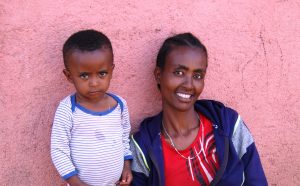Using stool samples to diagnose TB in children with Xpert is now recommended by the WHO. KNCV Tuberculosis Foundation is thrilled with this recommendation. “Our hard work payed off. We demonstrated that TB can be diagnosed with Xpert on stool samples using a very simple processing method, which we call the KNCV Simple One-Step Stool Method”, says Kitty van Weezenbeek, executive director of KNCV. “This can save the lives of many children around the world.”
Current challenges for diagnosing TB in children
The current methods used to diagnose TB in children depend on the availability of sputum. Children, however cannot produce this on command: when they cough, they swallow their sputum. The swallowed sputum can be collected using nasogastric aspiration (a tube inserted through the nose into the stomach). This is often painful and can be traumatizing for children, parents and health care workers. This procedure is therefore often only done when children are very ill. A less invasive, but still stressful procedure, is sputum induction.
While the Xpert machine is now becoming widely accessible, the equipment and skills for nasogastric aspiration or sputum induction are not. This is another reason why so many children go undiagnosed or that TB is detected at a late stage. Sometimes too late to save the child.
The use of stool samples on Xpert
The WHO rapid communication from January 2020 which recommends the use of Xpert on stool samples in addition to sputum, denotes an important breakthrough in TB diagnosis in children. Obviously obtaining stool is easy and painless. The current methods used to detect the TB bacterium in stool however are complex and only possible in well-equipped laboratories. With the Simple One-Step (SOS) Stool Method, KNCV proved that a much simpler method can be used to prepare stool for Xpert testing at no additional cost. The SOS Stool Method uses the same buffer and cartridge as those used for the Xpert sputum test. With only a short training required, laboratory staff can easily conduct this test. Just as with sputum, using Xpert on a stool sample can detect if a child has TB. Furthermore the test can also detect multidrug resistant (MDR) TB.
Recommendations for NTPs
This breakthrough – using Xpert on stool instead of sputum samples – provides the opportunity for NTPs to easily test more children with presumptive TB, in a child friendly manner. This is expected to result in a higher number of children being diagnosed with TB and mulitdrug resistant TB and in turn means less children will be ‘missed’. This is consistent with NTPs missions to find and treat more children with TB.
KNCV recommends NTPs to add stool testing to the national algorithms for diagnosing TB in children. The current round of National Strategic Plan development and the Global Fund funding cycle offers an opportunity to secure sufficient budget for rapid implementation, so that more children can be diagnosed and cured. Budget is needed to cover the costs of training for laboratory staff and treatment providers to use the new algorithm, and to purchase the Xpert cartridges to test the children.
Background and developments around the KNCV Simple One-Step (SOS) Stool Method
At KNCV, we find it unacceptable that worldwide almost 600 children die of TB every day. Therefore we explored the possibilities to detect TB in stool, aiming for methods that are as simple and sensitive as Xpert testing on sputum samples. With funding, raised by our own colleagues taking part in a run, we provided the ‘proof of concept’ for the SOS Stool Method. The NTPs of Ethiopia and Indonesia and partners joined our mission. The very promising preliminary results were presented at the Union Conferences in 2018 and 2019.
In Ethiopia and Indonesia, KNCV is currently refining the Standard Operating Procedures (SOP’s) for wider use and is working on defining the robustness of the SOS Stool Method. This is done by comparing this method to the current routine procedure of sputum (nasogastric aspiration) samples in combination with clinical diagnosis. Children with presumptive TB at cooperating health care facilities leave both samples to be tested. Results are expected this summer.
At the same time, astudy is comparing KNCV’s SOS Stool Method with other, more complex stool processing methods for Xpert testing under development. The mid-term results of this study are also expected this summer.
KNCV is ready to support countries with the implementation of the SOS Stool Method for children. A training package will be available by the third quarter of 2020. For more information, please contact edine.tiemersma@kncvtbc.org.
The story of Issayas
Issayas, a toddler from Addis Ababa (Ethiopia) is one of the children who got diagnosed with TB using KNCV’s SOS Stool Method. “I hope that in the future, children will only have to leave stool and not undergo painful other tests”, says his mother Almaz. Read the full story of Issayas here.





